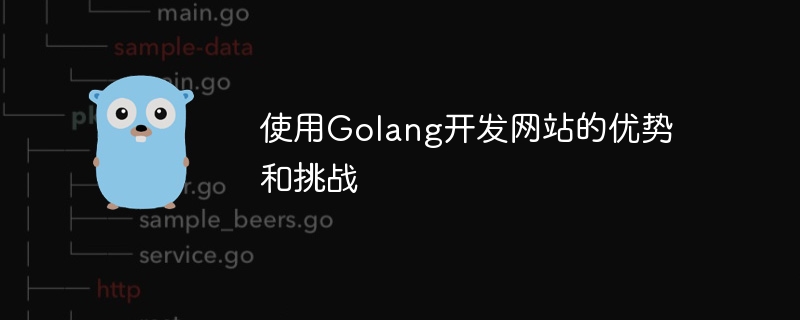Home >Backend Development >Golang >Advantages and challenges of developing websites using Golang
Advantages and challenges of developing websites using Golang
- PHPzOriginal
- 2024-03-18 19:06:041308browse

Advantages and challenges of using Golang to develop websites
With the rapid development of the Internet, more and more developers are paying attention to using Golang (also known as Go language ) to develop the website. Golang is an open source programming language developed by Google and designed for building efficient, reliable and concise software. Golang has many advantages when developing websites, but it also faces some challenges. This article will explore the advantages and challenges of using Golang to develop websites and provide specific code examples.
Advantages
1. Efficient performance
Golang is a statically typed language with excellent performance. Its concurrency model and lightweight threads (goroutines) can better utilize multi-core processors, making the website more responsive. The following is a simple example showing how to use goroutines to implement concurrent requests:
package main
import (
"fmt"
"net/http"
"time"
)
func fetchURL(url string) {
resp, err := http.Get(url)
if err != nil {
fmt.Println("Error fetching URL:", err)
return
}
defer resp.Body.Close()
fmt.Println("Fetched:", url)
}
func main() {
urls := []string{"https://example.com", "https://google.com", "https://github.com"}
start := time.Now()
for _, url := range urls {
go fetchURL(url)
}
time.Sleep(2 * time.Second) // Wait for goroutines to finish
elapsed := time.Since(start)
fmt.Println("Total time:", elapsed)
}2. Concise and easy-to-read code
Golang’s syntax design is concise and clear, making the code easy to read and maintain. It has built-in support for dependency injection (via interfaces), making the code more modular and testable. The following is a simple example that demonstrates how to use interfaces to achieve unified access to different data sources:
package main
import (
"fmt"
)
type DataSource interface {
GetData() string
}
type Database struct{}
func (d Database) GetData() string {
return "Data from database"
}
type API struct{}
func (a API) GetData() string {
return "Data from API"
}
func fetchData(ds DataSource) {
fmt.Println(ds.GetData())
}
func main() {
db := Database{}
api := API{}
fetchData(db)
fetchData(api)
}Challenges
1. The ecosystem is not perfect
In contrast, Golang’s ecosystem is still not perfect compared to other popular languages. Although Golang has a rich standard library and open source community support, resources in some areas (such as graphical interface development) are relatively limited. Developers may need to develop their own or use third-party libraries to implement specific functions.
2. The learning curve is steep
Some concepts and features of Golang (such as concurrent programming, interfaces, reflection, etc.) may be difficult for beginners and require a certain learning curve. . Especially for developers without concurrent programming experience, understanding and correctly using goroutines and channels may take some time and practice.
Conclusion
Although Golang has many advantages when developing websites, it also has to face some challenges. Developers can evaluate whether to choose Golang as a tool for website development based on specific project needs and team background. By taking full advantage of Golang's efficient performance and concise and easy-to-read code, combined with appropriate third-party libraries and tools, developers can build high-quality website applications faster.
The above is the detailed content of Advantages and challenges of developing websites using Golang. For more information, please follow other related articles on the PHP Chinese website!

